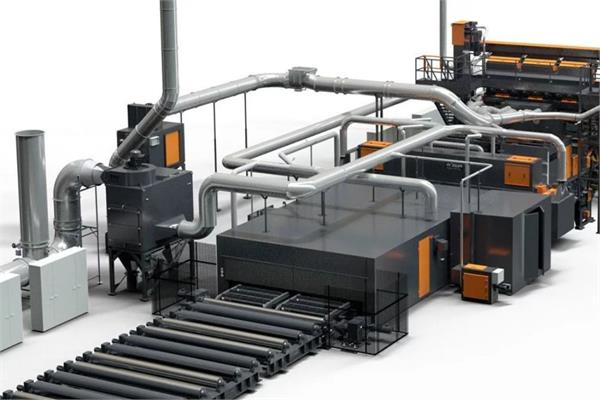
The Rösler preservation line represents a milestone in steel plate processing, reinforcing the company’s commitment to delivering top-tier solutions to the industry.
One of North America's largest steel producers has recently completed the construction of a state-of-the-art rolling mill for steel plates in an industrial park in the United States. This facility sets new benchmarks in steel plate production, both in size and productivity, making it one of the most advanced steel plants in the region.
In addition to manufacturing exceptionally thick and large rolled steel plates for the oil and offshore industries, the company has expanded its offerings by providing surface treatment services. This value-added service, widely embraced by the industry, is made possible through the integration of a Rösler preservation line, model KON 47/3-HD, specifically engineered for rolling mills.
Spanning 75 meters in length, with a blast media throughput of 3.7 metric tons/minute and an annual processing capacity of 122,000 metric tons, this Rösler preservation line is the largest ever designed and built by Rösler Oberflächentechnik GmbH. Such capability is crucial, as the steel plates processed in this facility are exceptionally large. Depending on the original steel slab thickness, these plates can reach widths of up to 4,300 mm, lengths of 18,000 mm, and thicknesses of up to 203 mm.
“These dimensions presented a real technical challenge. The blast cleaning operation for such large and heavy plates, with a maximum weight of over 45 metric tons, demands extra robust equipment that is not only extremely productive but also works with a high degree of precision. Otherwise, the specified surface cleanliness of SA 2,5 cannot be achieved. The technical requirements and a tight delivery time made this project very challenging,” has stated Marcus Witter, Global Sales Expert at Rösler.
The strategic placement of the Rösler preservation line at the final stage of the production process underscores its significance in the overall manufacturing chain. Unlike conventional surface treatment, this system offers customers a customisable service: they can opt for raw plates directly from the rolling mill, shot-blasted plates, or fully treated plates that are shot-blasted and coated.
“Depending on the final use of the steel plate, this choice can be an attractive additional value. For example, plates that must be transported over long distances can be prone to corrosion. In such cases it helps to blast-clean the plates and apply a corrosion-resistant coating. This not only protects the plates during transport but, at the same time, saves two steps in the customer’s own production: He can immediately cut and weld the material without having to remove the weldable primer,” has added Marcus Witter.
The preservation line predominantly employs solvent-based primers
tailored for shipbuilding and offshore applications, but it is also compatible with water-based lacquers to meet stringent environmental regulations. A critical component of the Rösler preservation line is the roller conveyor shot blast machine. It features a pre-heater equipped with two high-efficiency gas burners, heating workpieces to an optimal temperature of 260°C for subsequent painting. The blast machine itself is powered by ten Gamma 400G turbines, each with 30 kW of installed power. To optimize efficiency, an automatic width-recognition system selectively deactivates turbines when processing narrower plates, reducing wear and operational costs.
Considering the high weight of the workpieces (up to 7 metric tons per running meter), Rösler incorporated a heavy-duty roller conveyor system. To withstand the continuous high blast media throughput, the blast chamber is constructed from 8 mm thick manganese steel and lined with additional 8 mm thick exchangeable manganese steel plates.
After shot blasting, an integrated cleaning station ensures the plates are free of residual media and dust before entering the automatic paint booth. Using a two-component airless paint system, sensors detect plate width, length, and transport speed to minimise overspray and optimise paint consumption. The applied paint dries to a thickness of 15-25 µm before the plates are transferred to the drying system, which operates at approximately 60°C. A specialised slat conveyor prevents scratching on the lower surface, ensuring pristine results. Additionally, a thermal post-combustion system purifies exhaust air from the painting and drying processes, ensuring compliance with environmental regulations.
“This represented a big challenge for the installation of the preservation line. But we did everything in our power to support our customer in meeting the tight project deadline. In the end we were successful, because the project teams on both sides were in daily contact with each other. The atmosphere between the customer and us was always characterized by a high degree of cooperation. In the end we could successfully conclude this challenging project,” has concluded Marcus Witter.